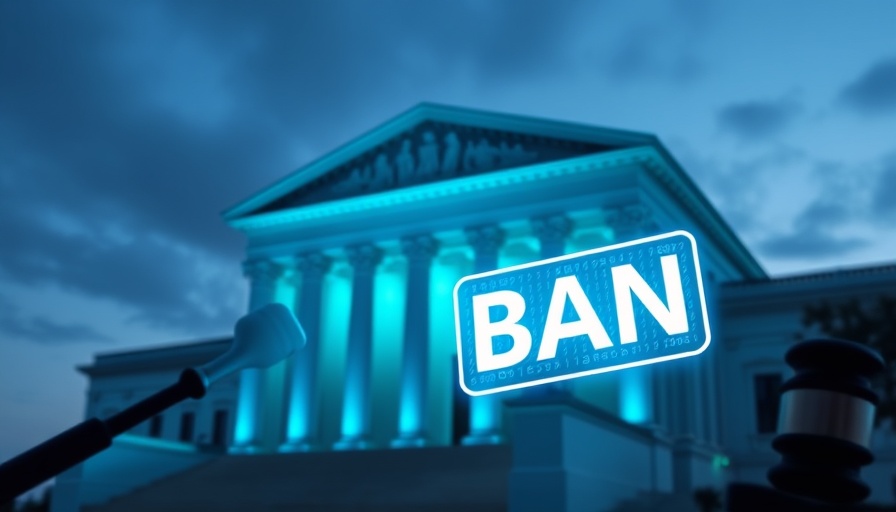
Unveiling the AI Regulation Dilemma
The recent decision by House Republicans to include a 10-year ban prohibiting states from regulating artificial intelligence (AI) has stirred controversy across various sectors. This surprising move, embedded within a larger tax bill, aims to provide a boost for AI development but raises significant legal and ethical questions. What does this mean for the future of AI, governance, and the interplay between federal and state powers?
The Promise and Peril of AI Expansion
The AI industry is positioned as a critical driver of innovation, with the potential to reshape numerous fields ranging from healthcare to finance. Supporters of the ban argue that a unified regulatory approach is essential to facilitate interstate commerce and maintain competitiveness. The provision, which prevents state and local regulations on AI systems, might expedite technological advancements, allowing for rapid deployment without local impediments, thus enabling major corporations to operate without the worry of state-by-state compliance.
However, critics warn that such a sweeping ban may compromise public accountability. Local governments often serve as the frontline defenders of citizens' rights, ensuring that technology does not infringe upon privacy or lead to discrimination. The decision to centralize power over AI regulation can leave vulnerable populations unprotected from the potential harms of automated decision-making systems, which may already be generating biased outcomes in hiring practices or lending.
Congressional Dynamics: A Bridge Too Far?
Despite its implications, the proposed ban's enactment faces formidable obstacles in the Senate. Legal experts, like Senator Cornyn, question whether the provision might pass through stringent Senate procedures, particularly under the Byrd Rule, which mandates that budget reconciliation bills must primarily address budgetary concerns rather than policy changes. This raises the question: can meaningful AI legislation emerge from such a deeply divided Congress, where bipartisanship remains elusive?
An example of bipartisan interest in the realm of AI regulation is the increasing scrutiny over practices like revenge porn, where legislation aimed at penalizing distribution without consent is gaining traction. In contrast to expansive provisions that would stifle state-level interventions, this measure represents a targeted approach that acknowledges the need for regulatory frameworks tailored for specific applications of technology.
The Implications of a Federal Ban on State Regulations
The clause in question explicitly states, "no state or political subdivision may enforce any law or regulation regulating artificial intelligence models, artificial intelligence systems, or automated decision systems." Such sweeping power, if left unrestricted for a decade, could stifle regional innovation hubs enthusiastic to explore ethical boundaries while developing AI technologies. In states with progressive reforms aimed at protecting consumer rights, especially concerning algorithmic transparency and bias, a federal ban might dilute the momentum needed to address these issues at a local level.
Public Backlash and the Fight for Democratic Oversight
Public outrage is already mounting against perceived governmental overreach. Advocates for civil liberties and tech equity argue that federal governance of AI must involve substantial public discourse and consideration of localized needs. Without checks and balances, the trend towards deregulation could exacerbate existing inequalities and misuse of technologies. A striking parallel can be drawn to historical instances where concentrated controls led to public backlash and demands for accountability, showcasing the need for balanced oversight tailored to citizen safety.
What’s Next? The Future of AI Regulation
The trajectory of AI regulation will hinge on multiple factors, including technological advancements, public sentiment, and bipartisan efforts to find common ground. While many lawmakers express concerns over the need for structured oversight, the intricacies of governance become apparent: how does one harmonize innovation with accountability? As various sectors express their position on this evolving landscape, the path forward remains fraught with challenges yet ripe with opportunity.
Conclusion: The Call for Ethical Policymaking
As stakeholders digest the potential ramifications of banning state-level AI regulations, it becomes clear that a narrative advocating for ethical policymaking is more relevant than ever. The forthcoming weeks will reveal the resilience of democratic processes in the digital age, challenging both lawmakers and constituents to confront the nuanced relationship between technology and regulation. Advocates must rally for a balanced approach to ensure that the rapid advancement of AI doesn't outpace ethical standards and public safety, lest we find ourselves in a tech landscape devoid of oversight.
 Add Row
Add Row  Add
Add 




 Add Row
Add Row  Add
Add 

Write A Comment